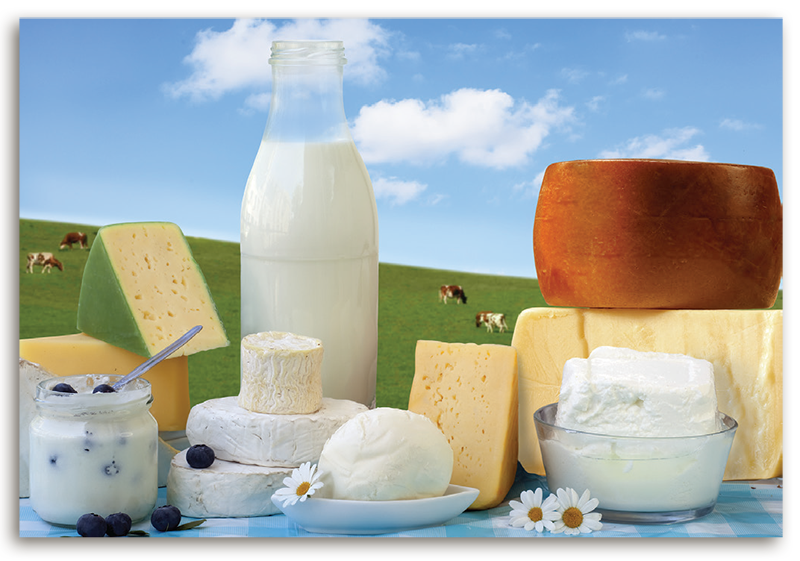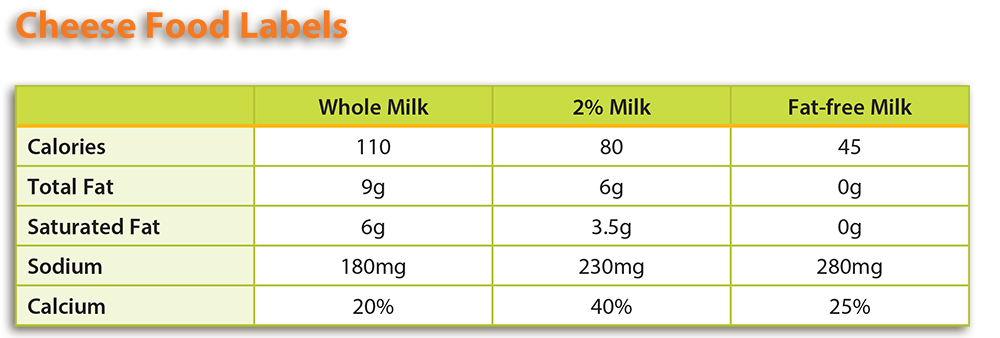FoodMASTER Middle: Cheese
Students will learn about the Law of Conservation of Mass by exploring environmental factors that can impact protein coagulation in milk (cheese-making process). By making qualitative and quantitative observations they will test three possible methods of making curds and whey.

Background
Lesson Activities
Recommended Companion Resources
Credits
Author
FoodMASTER
Acknowledgements
This lesson was partnered with East Carolina University. The FoodMASTER program was supported by the Science Education Partnership Award (SEPA) which is funded from the National Center for Research Resources, a component of the National Institutes of Health.
- Primary Authors:
- Virginia Stage, PhD, RDN, LDN
- Mary White
- Ashley Roseno, MAEd, MS, RDN, LDN
- Melani W. Duffrin, PhD, RDN, LDN
- Graphic Design: Cara Cairns Design, LLC
Sources
- https://www.cheeserank.com/post/cheese-facts-you-didnt-know
- https://www.cheeserank.com/post/cheese-mental-health
- http://www.todayifoundout.com/index.php/2010/11/why-swiss-cheese-has-holes-in-it/
Standards
Texas Content Area Standards
-
Principles of Agriculture, Food, and Natural Resources: 130.2.c.1
The student demonstrates professional standards/employability skills as required by business and industry. The student is expected to:
- Principles of Agriculture, Food, and Natural Resources: 130.2.c.1.A: identify career development, education, and entrepreneurship opportunities in the field of agriculture, food, and natural resources.
- Principles of Agriculture, Food, and Natural Resources: 130.2.c.1.B: apply competencies related to resources, information, interpersonal skills, problem solving, critical thinking, and systems of operation in agriculture, food, and natural resources.
- Principles of Agriculture, Food, and Natural Resources: 130.2.c.1.C: demonstrate knowledge of personal and occupational safety, environmental regulations, and first-aid policy in the workplace.
-
Principles of Agriculture, Food, and Natural Resources: 130.2.c.4
The student explains the historical, current, and future significance of the agriculture, food, and natural resources industry. The student is expected to:
- Principles of Agriculture, Food, and Natural Resources: 130.2.c.4.B: analyze the scope of agriculture, food, and natural resources and its effect upon society.
-
Principles of Agriculture, Food, and Natural Resources: 130.2.c.6
The student demonstrates appropriate personal and communication skills. The student is expected to:
- Principles of Agriculture, Food, and Natural Resources: 130.2.c.6.A: demonstrate written and oral communication skills appropriate for formal and informal situations such as prepared and extemporaneous presentations.
- Principles of Agriculture, Food, and Natural Resources: 130.2.c.6.B: demonstrate effective listening skills appropriate for formal and informal situations.
-
Principles of Agriculture, Food, and Natural Resources: 130.2.c.13
The student describes the principles of food products and processing systems. The student is expected to:
- Principles of Agriculture, Food, and Natural Resources: 130.2.c.13.A: evaluate food products and processing systems.
- Principles of Agriculture, Food, and Natural Resources: 130.2.c.13.B: determine trends in world food production.
- Principles of Agriculture, Food, and Natural Resources: 130.2.c.13.C: discuss current issues in food production.
- Principles of Agriculture, Food, and Natural Resources: 130.2.c.13.D: use tools, equipment, and personal protective equipment common to food products and processing systems.
-
ELA: 6.110.22.b.1
Developing and sustaining foundational language skills: listening, speaking, discussion, and thinking- oral language. The student develops oral language through listening, speaking, and discussion.
- ELA: 6.1.B: The student is expected to follow and give oral instructions that include multiple action steps.
-
ELA: 6.110.22.b.3
Developing and sustaining foundational language skills: listening, speaking, reading, writing, and thinking--fluency. The student reads grade-level text with fluency and comprehension. The student is expected to adjust fluency when reading grade-level text based on the reading purpose.
- ELA: 6.b.3: Developing and sustaining foundational language skills: listening, speaking, reading, writing, and thinking--fluency. The student reads grade-level text with fluency and comprehension. The student is expected to adjust fluency when reading grade-level text based on the reading purpose.
-
ELA: 6.110.22.b.5
Comprehension skills: listening, speaking, reading, writing, and thinking using multiple texts. The student uses metacognitive skills to both develop and deepen comprehension of increasingly complex texts.
- ELA: 6.5.G: The student is expected to evaluate details read to determine key ideas.
- ELA: 6.5.H: The student is expected to synthesize information to create new understanding.
-
ELA: 6.110.22.b.6
Response skills: listening, speaking, reading, writing, and thinking using multiple texts. The student responds to an increasingly challenging variety of sources that are read, heard, or viewed.
- ELA: 6.6.E: The student is expected to interact with sources in meaningful ways such as notetaking, annotating, freewriting, or illustrating.
-
ELA: 7.110.23.b.1
Developing and sustaining foundational language skills: listening, speaking, discussion, and thinking- oral language. The student develops oral language through listening, speaking, and discussion.
- ELA: 7.1.B: The student is expected to follow and give complex oral instructions to perform specific tasks, answer questions, or solve problems.
-
ELA: 7.110.23.b.3
Developing and sustaining foundational language skills: listening, speaking, reading, writing, and thinking--fluency. The student reads grade-level text with fluency and comprehension. The student is expected to adjust fluency when reading grade-level text based on the reading purpose.
- ELA: 7.b.3: Developing and sustaining foundational language skills: listening, speaking, reading, writing, and thinking--fluency. The student reads grade-level text with fluency and comprehension. The student is expected to adjust fluency when reading grade-level text based on the reading purpose.
-
ELA: 7.110.23.b.5
Comprehension skills: listening, speaking, reading, writing, and thinking using multiple texts. The student uses metacognitive skills to both develop and deepen comprehension of increasingly complex texts.
- ELA: 7.5.G: The student is expected to evaluate details read to determine key ideas.
- ELA: 7.5.H: The student is expected to synthesize information to create new understanding.
-
ELA: 7.110.23.b.6
Response skills: listening, speaking, reading, writing, and thinking using multiple texts. The student responds to an increasingly challenging variety of sources that are read, heard, or viewed.
- ELA: 7.6.E: The student is expected to interact with sources in meaningful ways such as notetaking, annotating, freewriting, or illustrating.
-
ELA: 8.110.24.b.1
Developing and sustaining foundational language skills: listening, speaking, discussion, and thinking- oral language. The student develops oral language through listening, speaking, and discussion.
- ELA: 8.1.B: The student is expected to follow and give complex oral instructions to perform specific tasks, answer questions, or solve problems.
-
ELA: 8.110.24.b.3
Developing and sustaining foundational language skills: listening, speaking, reading, writing, and thinking--fluency. The student reads grade-level text with fluency and comprehension. The student is expected to adjust fluency when reading grade-level text based on the reading purpose.
- ELA: 8.b.3: Developing and sustaining foundational language skills: listening, speaking, reading, writing, and thinking--fluency. The student reads grade-level text with fluency and comprehension. The student is expected to adjust fluency when reading grade-level text based on the reading purpose.
-
ELA: 8.110.24.b.5
Comprehension skills: listening, speaking, reading, writing, and thinking using multiple texts. The student uses metacognitive skills to both develop and deepen comprehension of increasingly complex texts.
- ELA: 8.5.G: The student is expected to evaluate details read to determine key ideas.
- ELA: 8.5.H: The student is expected to synthesize information to create new understanding.
-
ELA: 8.110.24.b.6
Response skills: listening, speaking, reading, writing, and thinking using multiple texts. The student responds to an increasingly challenging variety of sources that are read, heard, or viewed.
- ELA: 8.6.E: The student is expected to interact with sources in meaningful ways such as notetaking, annotating, freewriting, or illustrating.
-
Math: 6.111.26.b.3
Number and operations. The student applies mathematical process standards to represent addition, subtraction, multiplication, and division while solving problems and justifying solutions.
- Math: 6.3.D: The student is expected to add, subtract, multiply, and divide integers fluently.
- Math: 6.3.E: The student is expected to multiply and divide positive rational numbers fluently.
-
Math: 6.111.26.b.4
Proportionality. The student applies mathematical process standards to develop an understanding of proportional relationships in problem situations.
- Math: 6.4.H: The student is expected to convert units within a measurement system, including the use of proportions and unit rates.
-
Math: 7.111.27.b.3
Number and operations. The student applies mathematical process standards to add, subtract, multiply, and divide while solving problems and justifying solutions.
- Math: 7.3.A: The student is expected to add, subtract, multiply, and divide rational numbers fluently.
- Math: 7.3.B: The student is expected to apply and extend previous understandings of operations to solve problems using addition, subtraction, multiplication, and division of rational numbers.
-
Math: 7.111.27.b.4
Proportionality. The student applies mathematical process standards to represent and solve problems involving proportional relationships.
- Math: 7.4.E: The student is expected to convert between measurement systems, including the use of proportions and the use of unit rates.
-
Science: 6.112.26.b.1
Scientific and engineering practices. The student, for at least 40% of instructional time, asks questions, identifies problems, and plans and safely conducts classroom, laboratory, and field investigations to answer questions, explain phenomena, or design solutions using appropriate tools and models. The student is expected to:
- Science: 6.112.26.b.1.A: ask questions and define problems based on observations or information from text, phenomena, models, or investigations
- Science: 6.112.26.b.1.B: use scientific practices to plan and conduct descriptive, comparative, and experimental investigations and use engineering practices to design solutions to problems
- Science: 6.112.26.b.1.C: use appropriate safety equipment and practices during laboratory, classroom, and field investigations as outlined in Texas Education Agency-approved safety standards;
- Science: 6.112.26.b.1.D: use appropriate tools such as graduated cylinders, metric rulers, periodic tables, balances, scales, thermometers, temperature probes, laboratory ware, timing devices, pH indicators, hot plates, models, microscopes, slides, life science models, petri dishes, dissecting kits, magnets, spring scales or force sensors, tools that model wave behavior, satellite images, hand lenses, and lab notebooks or journals;
- Science: 6.112.26.b.1.E: collect quantitative data using the International System of Units (SI) and qualitative data as evidence;
-
Science: 6.112.26.b.2
Scientific and engineering practices. The student analyzes and interprets data to derive meaning, identify features and patterns, and discover relationships or correlations to develop evidence-based arguments or evaluate designs. The student is expected to:
- Science: 6.112.26.b.2.B: analyze data by identifying any significant descriptive statistical features, patterns, sources of error, or limitations;
- Science: 6.112.26.b.2.C: use mathematical calculations to assess quantitative relationships in data; and
-
Science: 7.112.27.b.1
Scientific and engineering practices. The student, for at least 40% of instructional time, asks questions, identifies problems, and plans and safely conducts classroom, laboratory, and field investigations to answer questions, explain phenomena, or design solutions using appropriate tools and models. The student is expected to:
- Science: 7.112.27.b.1.A: ask questions and define problems based on observations or information from text, phenomena, models, or investigations;
- Science: 7.112.27.b.1.B: use scientific practices to plan and conduct descriptive, comparative, and experimental investigations and use engineering practices to design solutions to problems;
- Science: 7.112.27.b.1.C: use appropriate safety equipment and practices during laboratory, classroom, and field investigations as outlined in Texas Education Agency-approved safety standards;
- Science: 7.112.27.b.1.D: use appropriate tools such as graduated cylinders, metric rulers, periodic tables, balances, scales, thermometers, temperature probes, laboratory ware, timing devices, pH indicators, hot plates, models, microscopes, slides, life science models, petri dishes, dissecting kits, magnets, spring scales or force sensors, tools that model wave behavior, satellite images, hand lenses, and lab notebooks or journals;
- Science: 7.112.27.b.1.E: collect quantitative data using the International System of Units (SI) and qualitative data as evidence;
-
Science: 7.112.27.b.2
Scientific and engineering practices. The student analyzes and interprets data to derive meaning, identify features and patterns, and discover relationships or correlations to develop evidence-based arguments or evaluate designs. The student is expected to:
- Science: 7.112.27.b.2.B: analyze data by identifying any significant descriptive statistical features, patterns, sources of error, or limitations;
- Science: 7.112.27.b.2.C: use mathematical calculations to assess quantitative relationships in data; and
-
Science: 7.112.27.b.6
Matter and energy. The student distinguishes between elements and compounds, classifies changes in matter, and understands the properties of solutions. The student is expected to:
- Science: 7.112.27.b.6.C: distinguish between physical and chemical changes in matter;
-
Science: 8.112.28.b.1
Scientific and engineering practices. The student, for at least 40% of instructional time, asks questions, identifies problems, and plans and safely conducts classroom, laboratory, and field investigations to answer questions, explain phenomena, or design solutions using appropriate tools and models. The student is expected to:
- Science: 8.112.28.b.1.A: ask questions and define problems based on observations or information from text, phenomena, models, or investigations;
- Science: 8.112.28.b.1.B: use scientific practices to plan and conduct descriptive, comparative, and experimental investigations and use engineering practices to design solutions to problems;
- Science: 8.112.28.b.1.C: use appropriate safety equipment and practices during laboratory, classroom, and field investigations as outlined in Texas Education Agency-approved safety standards;
- Science: 8.112.28.b.1.D: use appropriate tools such as graduated cylinders, metric rulers, periodic tables, balances, scales, thermometers, temperature probes, laboratory ware, timing devices, pH indicators, hot plates, models, microscopes, slides, life science models, petri dishes, dissecting kits, magnets, spring scales or force sensors, tools that model wave behavior, satellite images, weather maps, hand lenses, and lab notebooks or journals;
- Science: 8.112.28.b.1.E: collect quantitative data using the International System of Units (SI) and qualitative data as evidence;
-
Science: 8.112.28.b.2
Scientific and engineering practices. The student analyzes and interprets data to derive meaning, identify features and patterns, and discover relationships or correlations to develop evidence-based arguments or evaluate designs. The student is expected to:
- Science: 8.112.28.b.2.B: analyze data by identifying any significant descriptive statistical features, patterns, sources of error, or limitations;
- Science: 8.112.28.b.2.C: use mathematical calculations to assess quantitative relationships in data; and



